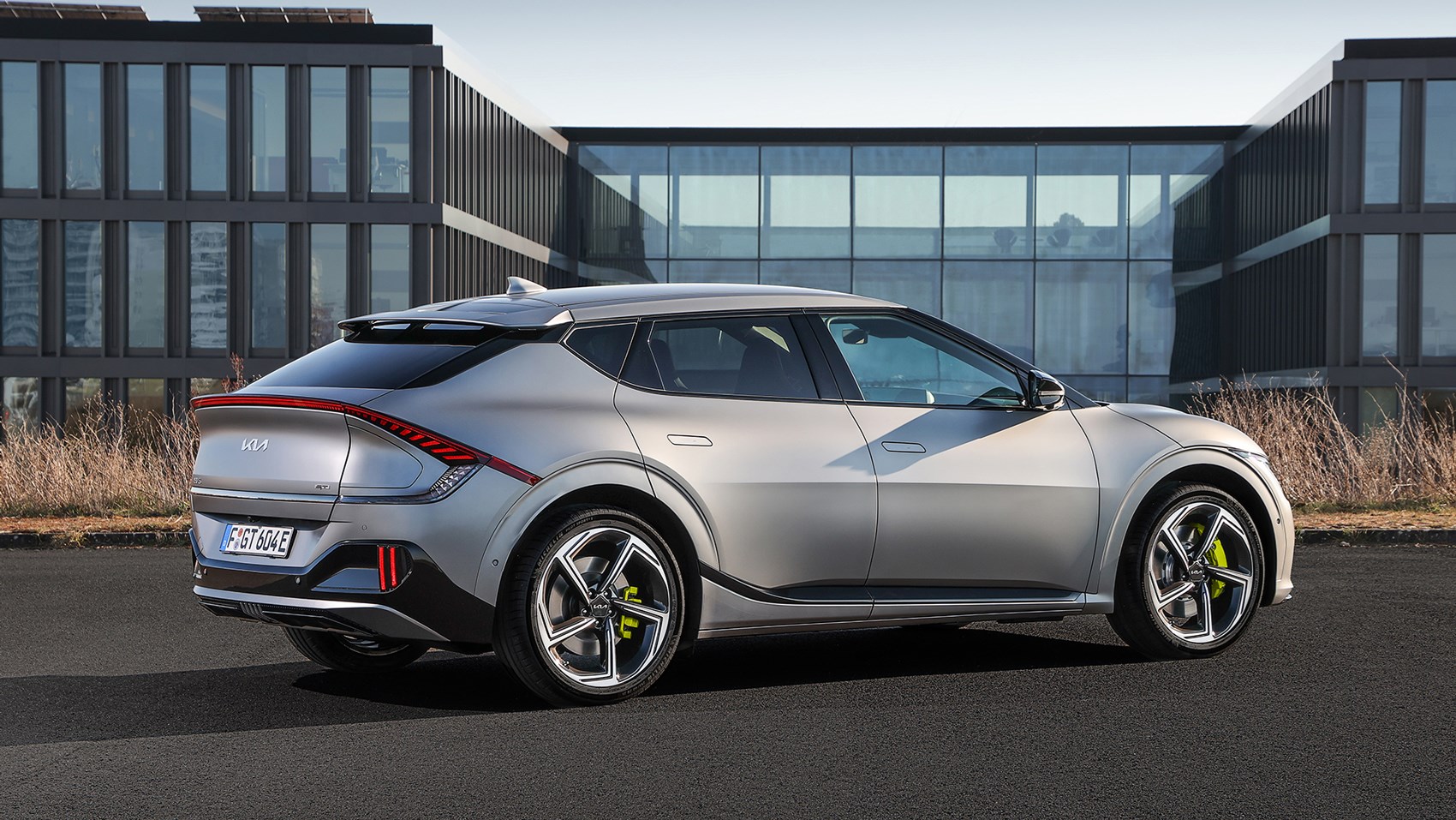► CAR tests the hot Kia EV6 GT
► We seek out the northernmost EV charger
► And visit the Svalbard Seed Vault
This content was part of CAR magazine’s 60th anniversary celebrations, split over three editions. Want to read more from those editions, as well as get access to more amazing content from CAR? Become a member here with a 99p trial!
The silence out here is overwhelming. No background noise, no human activity. Just the faint sploshing of water lapping at the boat’s sides, and the hulking glacier silently standing sentinel in front of us. Then a faint rumbling; indistinct crackles and groans from within the ice. We watch and wait, rapt, and then it happens: huge chunks of the glacier’s leading edge crumble and collapse into the water.
We’re at one of the many edges of Svalbard, the archipelago in the Arctic Ocean closer to the North Pole than Land’s End is to John o’Groats. On the other side of this body of water, where the sea cuts deepest into Svalbard’s largest land mass, is the world’s northernmost town, Longyearbyen. At its dock, the quickest ever Kia production car is being unloaded. We’ve already covered more than 600 miles in the all-electric EV6 GT back on the Norwegian mainland, and its next challenge is to explore Svalbard. While it’s being readied we’ve turned tourist with a boat trip to the glaciers framing the horizon opposite Longyearbyen. It’s an awe-inspiring experience – walruses sunbathing, Arctic birds skimming the waves, a fleeting glimpse of a whale surfacing – and a sobering one, too.

This glacier-crumbling process – calving, it’s called – is natural but it’s occurring more frequently than it used to. ‘It happens every time I’m here,’ says the boat’s captain. Scientific studies indicate Svalbard is the fastest-heating place on the planet. Temperatures have risen by 4ºC in the last 50 years. The winter season ends two months earlier than it did in the ’70s and it’s becoming wetter as well as warmer. Increased rainfall caused a fatal avalanche overnight at Longyearbyen in 2015, destroying homes close to a hillside.
The other side of Longyearbyen, built into a sandstone mountain overlooking the town, above the worst-case scenario for sea rise, is the Global Seed Vault: a Norway-funded global food security back-up, containing 1.2 million crop samples – the largest collection of crop diversity on earth – securely deposited from gene banks all over the world. In the event of war, floods, fires or lack of resources to keep seeds alive, its depositors can withdraw crop seeds to begin again.
The planet is in trouble. We know that. Perhaps the shift to electric cars will help us hurt it less; perhaps it won’t; perhaps it’s too late; perhaps there’s still hope. This adventure can’t provide answers to the biggest questions but it does allow us to explore some smaller ones. If the battery-electric car will soon dominate personal transport, can a journey into the Arctic Circle be the ultimate retort to range anxiety? On the way there, is Norway as much of a breeze for electric driving as its EV-leader status suggests? And, more prosaically, what does the fastest car Kia’s ever made feel like to drive? Can it be an effortless grand tourer – even at the top of the civilised world?
Oh, and Svalbard is home to the world’s northernmost public EV charging point – can we plug the Kia into it? (And will someone else already be using it when we get there?) All of this makes Svalbard a great place for examining some tricky issues, while driving an intriguing new electric car.
The car for the job
Let’s rewind eight days to where this adventure started. Mo i Rana, in northern Norway, is sometimes called the Gateway to the North. It’s one of the closest places to the Arctic Circle easily reached by commercial flight.
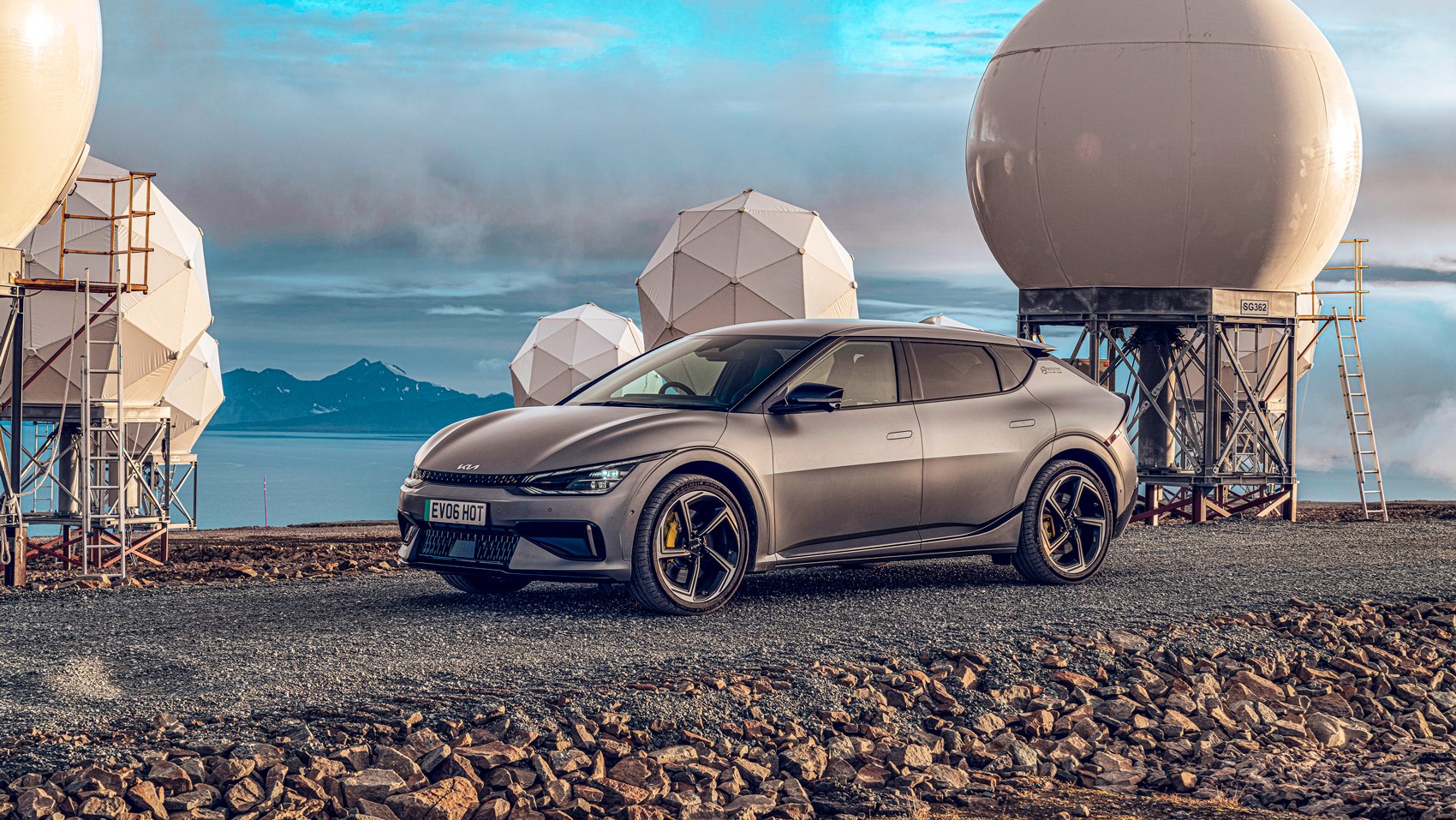
The EV6 GT is waiting for us as we step off a propeller plane at the more-scenic-than-average airport, framed by forest and snow-capped peaks. The GT is Kia’s new flagship, its most powerful and fastest-accelerating production car yet with a 0-62mph time of 3.5sec. It builds on the regular EV6’s performance with a simply enormous power and torque increase. A new rear motor and uprated front one give a 570bhp/546lb ft total, compared with the non-GT dual-motor EV6’s 321bhp/446lb ft (or the single-motor, rear-wheel-drive car’s 226bhp/257lb ft). There are upgrades too for cooling, steering, suspension, brakes (with lurid lime-green calipers) and more.
Price is £62k to the regular EV6’s £44k or £51k starting points for single- and dual-motor versions respectively. Stiff money for a family crossover but good bhp/£ value. Not many 570bhp cars are sub-£70k.
The GT version’s lost none of the EV6’s practicality; it takes our equipment with more space to spare than a Volvo V90 estate hire car we used briefly earlier in transit. With the best part of three metres between its front and rear wheels, it’s a truly roomy car.
A head-turning one, too. As we slip out of the quiet, quaint Old Town quarter and into free-flowing traffic, the GT gathers almost as much attention as if we were driving a supercar.
It’s supercar quick, too. We toggle through the modes using the switch on the left of the oddly shaped steering wheel: Eco, Normal and Sport. This pre-production car shoots forward with a kick as each new mode clicks in. It’s swift, no question. Eco mode, in which acceleration runs into a squidgy limiter, is more than fast enough.
On the right, however, there’s an extra lime-green GT mode switch. Wowzers. One press and the EV6 GT pings forward again like it’s hooked to a distant rocket sled and the line’s just pulled taut. Back to Eco mode, where it’ll spend most of the journey; between here and our final Norway stop at Tromsø I won’t often feel the compulsion, or find the space, to use GT mode again.
We’re making swift progress north up the Kystriksveien coast route, ever more idyllic with every passing mile. Tarmac runs parallel to looking-glass lakes and fjords, mirroring the horizon. Do people here get used to waking up to this scenery every morning, or does the novelty eventually wear off?
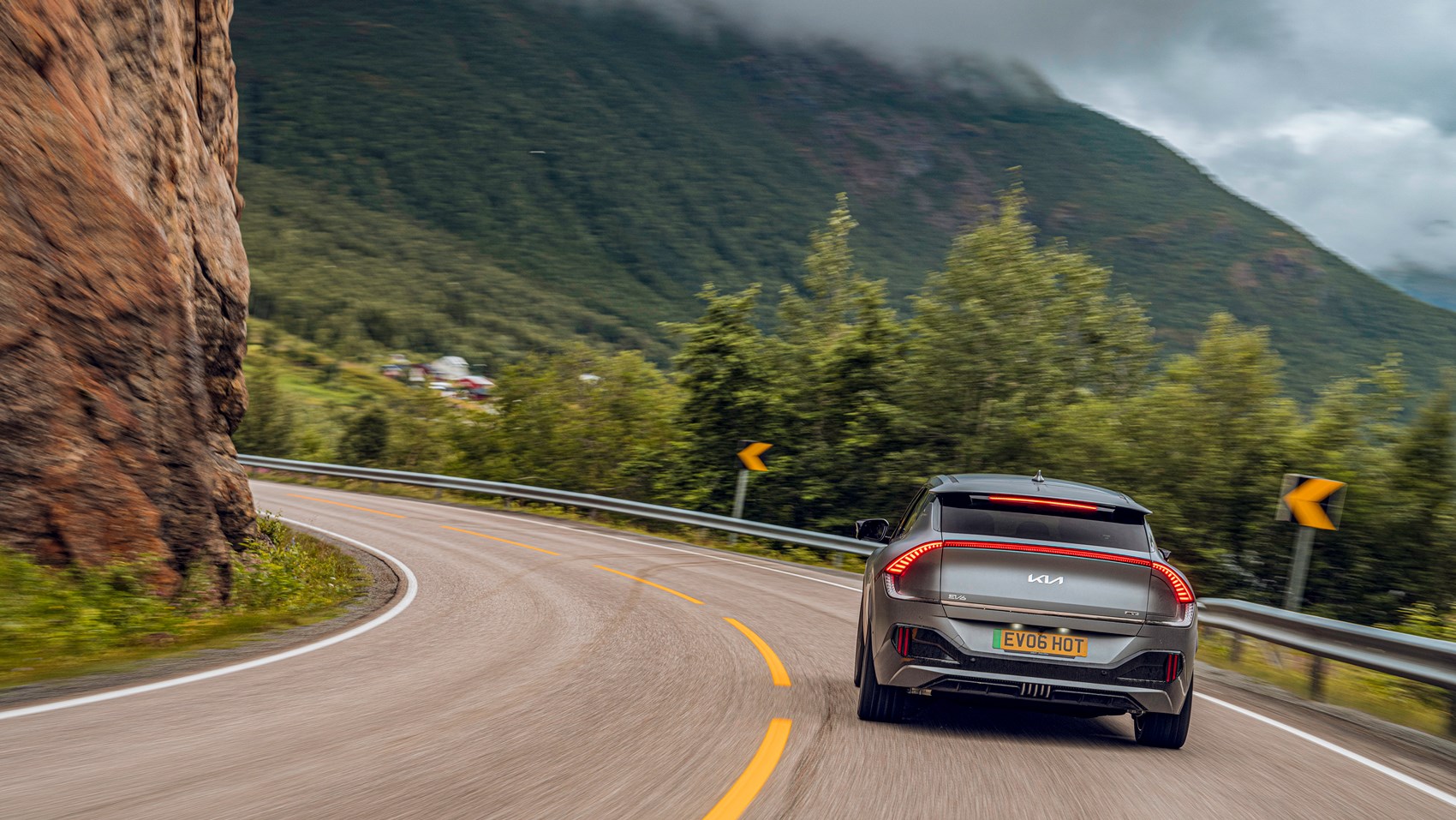
The EV6 GT makes for a tranquil companion, too. Despite the new front and rear springs, a 5mm lower ride height and stiffer rear anti-roll bar, it still rides sweetly and refinement is superb. The only black mark is for the driving position. I can’t quite get the triangle of hands, feet and hips in harmony, and find myself constantly adjusting the seat and wheel as the miles tick on.
When the roads get twisty, and quiet enough to scratch at least some of the surface of the epic performance, the GT handles too. Approaching an apex you can trail the brakes, or use the gearchange-style paddles, which adjust the amount of regen, tipping weight onto the GT’s nose. Then you get on the power early and feel the car hook up and power out. It’s enjoyable enough to make the most of a good road, even if there’s no getting away from the fact that this is still ultimately a heavy, tall car.
Almost every other car we encounter is electric and it’s not until we’re a long way north that combustion cars begin to outnumber EVs. Fast chargers aren’t hard to find; government policy is for a rapid charger to be located every 50km (31 miles) on a main road. Kia’s own Kia Charge subscription service app gives access to many of them.
We charge three times between Mo i Rana and Tromsø, one rapid top-up and two overnight trickles. Two go swimmingly; one won’t play ball initially and needs a call to the charging company to reset. It’s mid-afternoon when we gingerly edge the EV6 onto a shipping container at Tromsø’s docks, ready to be craned onto the Norbjørn cargo vessel. The sun won’t go down until well past midnight and even then it won’t set entirely. We’ve reached the extreme north, and 24-hour daylight.
It will take the Norbjørn three days to reach Svalbard via the Arctic Ocean – a relatively straightforward passage in summertime and a challenging one in winter, when it breaks its way through ice.
We travel by commercial flight, meanwhile, with naps troubled mildly by guilt-dreams of the journey’s overall carbon footprint. Mind you, despite my earlier driving-position gripe, I feel fresh and ache-free after three days’ solid driving.
Heading to Svalbard
An epic multi-day drive won’t be possible on Svalbard. Around 60 per cent of the archipelago is covered by glaciers, and although you can drive freely on European plates, there are only 25 miles of roads, all concentrated around the main town of Longyearbyen. About 2400 people call it home, and the remainder of Svalbard’s 2600 overall population is divided between the distant mining communities of Barentsburg and Pyramiden (the latter home to fewer than 10 people), and far-flung research stations accessible only by boat or snowmobile. Polar bears outnumber humans on Svalbard. When leaving the comparative safety of Longyearbyen’s road network, residents must take a rifle with them in case of attack, and tourists a rifle-equipped guide.
Let’s explore. It’s high summer when we visit, with average temperatures between 4º and 8ºC. In winter, -8ºC is about as warm as it gets. The weather’s chilly but comfortable today, which feels at once pleasant and disquieting given we’re just 818 miles from the North Pole. There are plenty of cars in town, many of them Toyotas (Longyearbyen is home to the world’s northernmost car dealership, a Toyota one) and hardy Subarus. We spy another EV shortly after arriving (it’s Hyundai’s sister car to the EV6, an Ioniq 5) and many of the vans are electric Nissans. Normal transport outside of summer is snowmobile and row upon row of skidoos are parked up in Longyearbyen, awaiting snowfall.
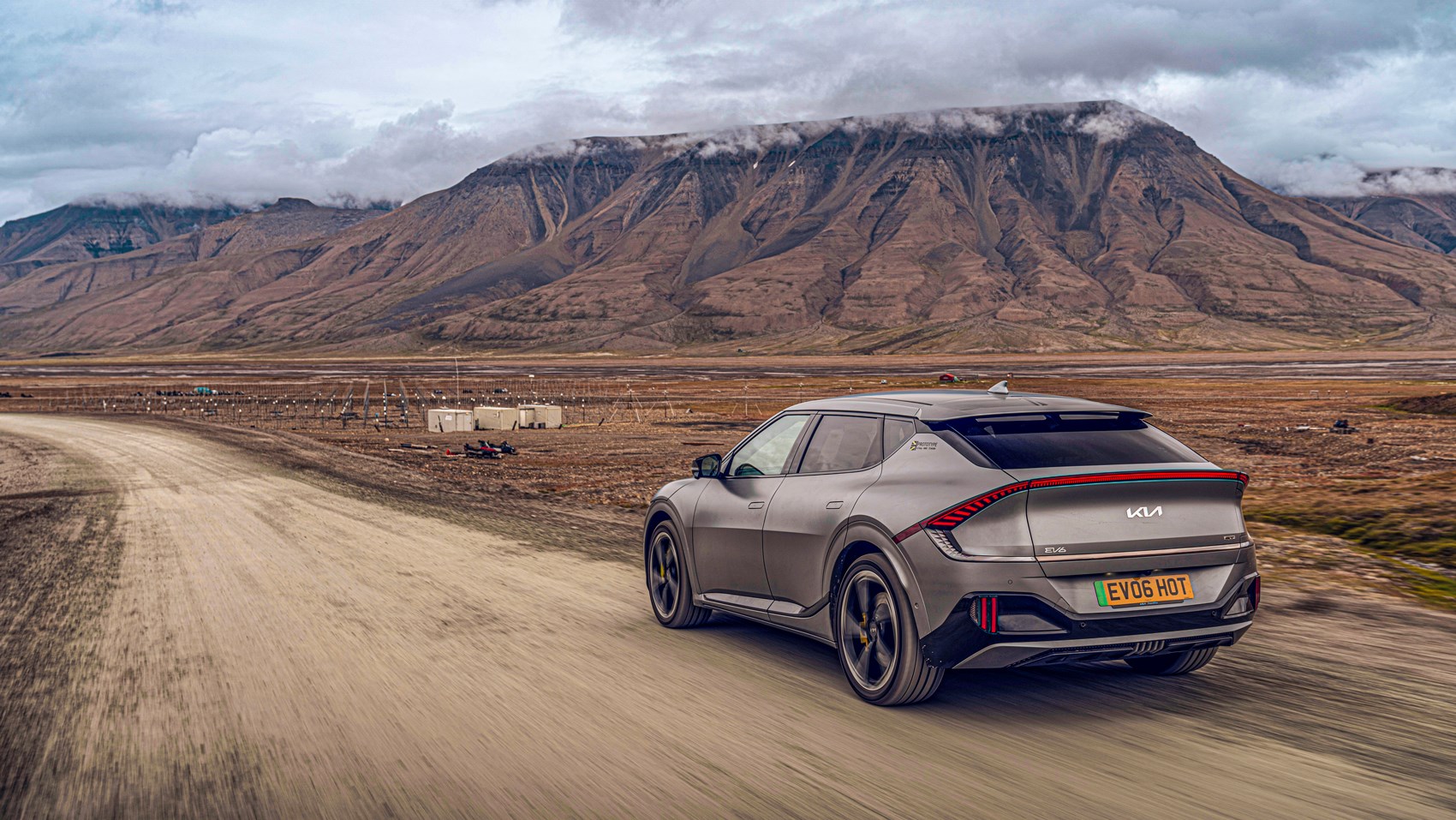
There’s a temporary traffic jam in the town centre while snow geese cross the road, and as we head out of town wheeled dog sleds pass the other way. Life is different here.
Tarmac runs out shortly after the town limits. Road tax is twice as high as mainland Norway to maintain the ice-ravaged surfaces. The EV6 is not a full-blown SUV but it is a genuinely capable crossover. It copes admirably as the road winds steeply and stonily past dormant mineshafts, and when we need to manage a little light rock-crawling it copes admirably. I’d feel less sure of the same manoeuvre in a Tesla Model Y, for example.
We pass a Road Closed sign. Beyond, on top of a plateau overlooking the planes landing at Svalbard airport some distance below, lies something quite astonishing. Marit, our guide from Svalbardguidene, has permission for us to access SvalSat, a field of ground satellites. More than 130 enormous white domes are lined up like gargantuan golf balls at a giant’s driving range. Each dome shelters a dish antenna which locks onto satellites and tracks them from horizon to horizon through the day or night. (Day and night is a relative concept here in summertime Svalbard. We’re under a sunset that will last several hours before blending into morning light.) They communicate with hundreds of scientific research satellites eyeing Earth, some of which are studying the impact of climate change. Oil-spill detection, glacier shrinkage, sea temperature and much more besides is measured here. It’s a surreally beautiful place. Under this light, amid these structures, it feels like we’re on the surface of Mars.
But it’s Earth’s fragility that Svalbard is both the most extreme example of (annual mean air temperature is expected to rise to 10ºC by 2100, a much sharper rate of increase than anywhere else on the planet) and at the vanguard of research into how mankind may cope with the ramifications of climate change.
Visiting the Seed Vault
We backtrack down the switchbacks that brought us up to the satellite station – a kind of chillier, more gravelly Stelvio Pass – and reach the Global Seed Vault, built into the same mountain plateau. As our tyres crunch up to the Seed Vault’s entrance a perfect storybook rainbow arcs across the base of the mountain. It feels like a suitably optimistic symbol of the potential to rebuild.
The Seed Vault, founded in 2008, is one of the world’s iconic buildings, yet only its entrance is visible. It extends deep into the mountain, its contents kept at a regulated -18ºC, helped by the permafrost. There’s a faint roar of cooling devices inside the adjacent prep station building but the site is deserted – there are no full-time staff on site and journalists are no longer allowed inside. A security camera keeps a watchful eye on the front door while stainless steel, mirrors and prisms at the top of the entrance turret reflect the sky, and in winter the northern lights too.
There are 1700 gene banks in the world but the Global Seed Vault is the only conservation project of its kind. It’s been dubbed the Doomsday Vault by some – a kind of hard-drive copy of agriculture for all mankind in the event of a global disaster – but that’s not an entirely accurate way to view its mission. It’s a safe place in which various gene banks around the world can deposit copies of the material they’ve stored at home. Seeds within the vault can theoretically remain viable for centuries. They’re stored in black-box conditions, meaning the depositors are the only ones who can withdraw their seeds. So far one withdrawal has been made, by a gene bank formerly located in Aleppo, Syria, partly destroyed by war. The samples from Svalbard have enabled the organisation to safely establish new gene banks elsewhere.
Even the Seed Vault isn’t immune to climate-change complications; melting permafrost flooded its access tunnel in 2017 and required costly upgrades to rectify. And not every type of crop can be preserved in there: coffee, cocoa and coconut seeds wouldn’t survive, for example.
We plug a kettle, bought back in Norway, into the EV6’s on-board power socket and make a coffee to drink while we sit and contemplate. (Its V2L, or Vehicle to Load, system can use up to 80 per cent of the battery’s capacity to power appliances and devices, or even charge another EV.)
The kettle’s barely touched the still-plenty-full battery but we want to charge the car here. After all, aside from the world’s most northerly chocolate factory, brewery, graveyard and Toyota dealership, Longyearbyen can also boast the northernmost public electric car charge point. It’s next to a wood-panelled shopping complex (built on stilts, like many of the buildings in the town, to keep it above the permafrost) and in front of a backdrop of jaggedly ridged, cloud-hugged mountains. It looks somehow nondescript and epic at the same time. A sign at the entrance politely reminds shoppers that rifles aren’t permitted indoors.

Remarkably, it appears on the Kia Charge app. We find Svalbard: a digital facsimile of the island, surrounded by ocean. And with two dots: two 6kW chargers are available. Except they’re blocked by an electric van that isn’t plugged in. Marit makes a call to the owners – Longyearbyen’s a small world – and they say we can just hop in and move it. The key’s inside: local polar bear safety guidelines recommend cars are left unlocked, in case any pedestrian needs sudden shelter from a marauding bear. We plug in, scan the Kia Charge card – it works! Truly, it seems the electric car infrastructure here has gone past a tipping point. We’re on the ceiling of the world, where bears outnumber humans, and you can rock up and charge via an app.
We’re charging on electricity provided by the coal-fired power station that creates the town’s energy for hot water and electricity. It will go diesel next year. Svalbard’s main industry until very recently was mining; today two mines remain, one outside Longyearbyen and one Russian-controlled mine at Barentsburg. The former is fully operational but will close shortly, due to environmental pressure.
Going electric is a more than knotty problem, with infinite tendrils to untangle. The environmental issues associated with manufacturing battery-electric cars and the complex ramifications of charging them are well publicised. Even if all electric cars are as consummately usable as the EV6, and become lighter and more efficient in the future, it’s not possible for them to work as well in every country as they do in Norway.

The Seed Vault is an intrinsically hopeful endeavour – evidence of mankind’s instinct to create and preserve rather than to destroy, with disparate countries and governments co-operating as one. A future based on battery transport cannot be a cure-all solution, and perhaps it will take behavioural changes deeper than the power source for cars alone to slow the environmental damage evident here. Perhaps it will take a global shift in mindset – adopting the same spirit that has resulted in the creation of the Global Seed Vault – to find a way to crack the personal transport code.
Verdict: Kia EV6 GT
Truly, the EV6 GT is impressive. Being pragmatic, the normal EV6 is all the electric car you need. But there’s always appeal in having the very best of something, and the GT is the ultimate example of one of the very best EVs on sale today at any price point. It hasn’t missed a beat on this voyage and if speed’s what you’re after, it really is mind-bendingly quick without losing any usability.
Riding shotgun with Albert Biermann in an EV6 GT prototype
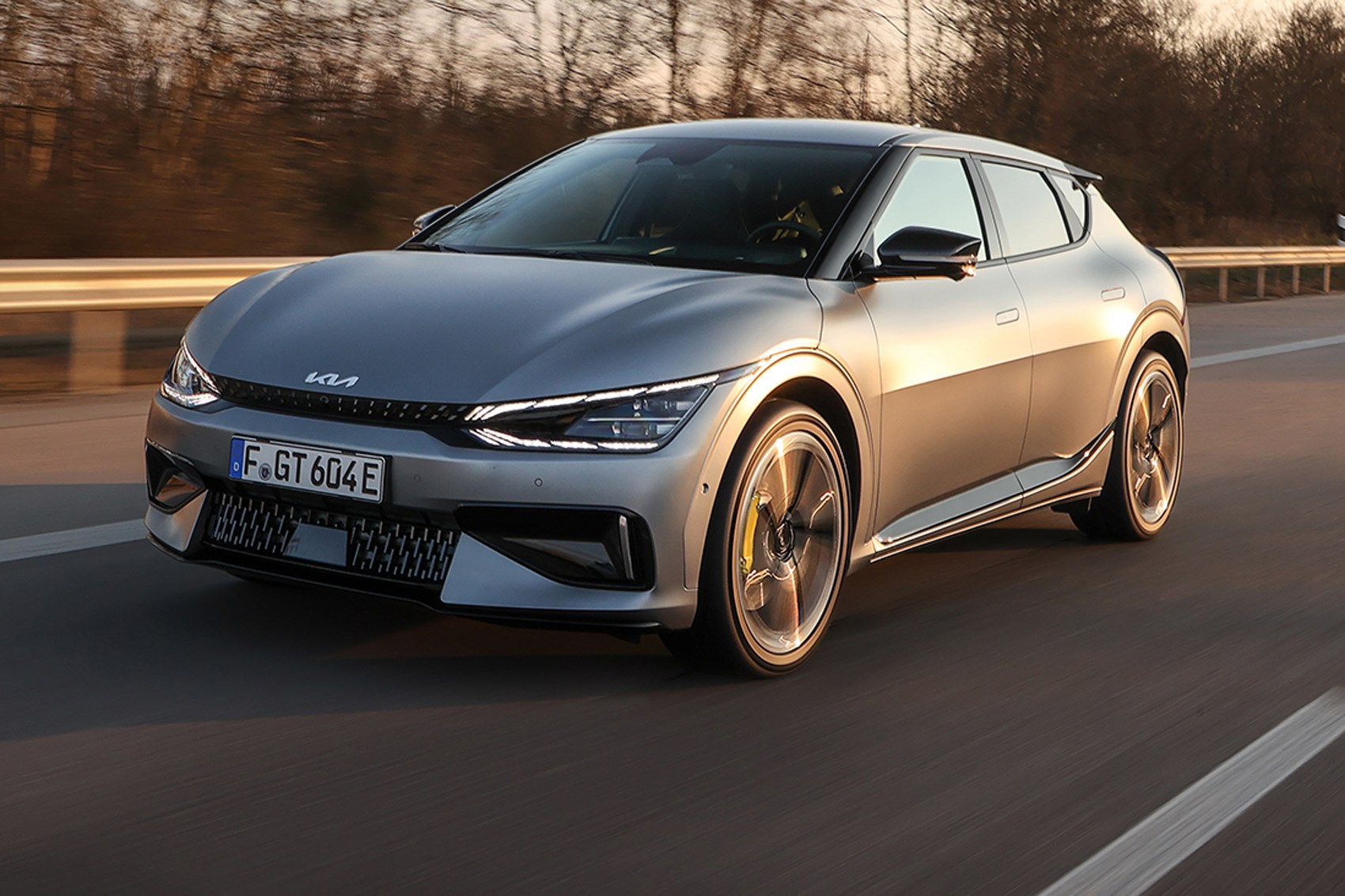
We already know the Kia EV6 is a very good car. We rate it highly as it offers loads of cutting-edge tech, solid range figures and fast-charging capabilities in a striking package. So we’re a little excited to try the faster new EV6 GT.
Its promises are great, bundling all of that stuff we love about the regular EV6 versions with Tesla-fighting performance to boot. CAR had a chance to ride as a passenger with handling whizz Albert Biermann at the wheel, navigating the streets of Frankfurt and blasting off down some of the city’s nearby autobahns.
What makes the Kia EV6 GT special?
First and foremost, Kia’s tweaked the look of its do-anything EV. Larger sportier wheels, a subtly aggressive bodykit with an aerodynamic spoiler element at the rear and flashes of neon green paint. Inside, those flashes of green continue with a bespoke GT button on the steering wheel and new, properly huggy bucket seats.
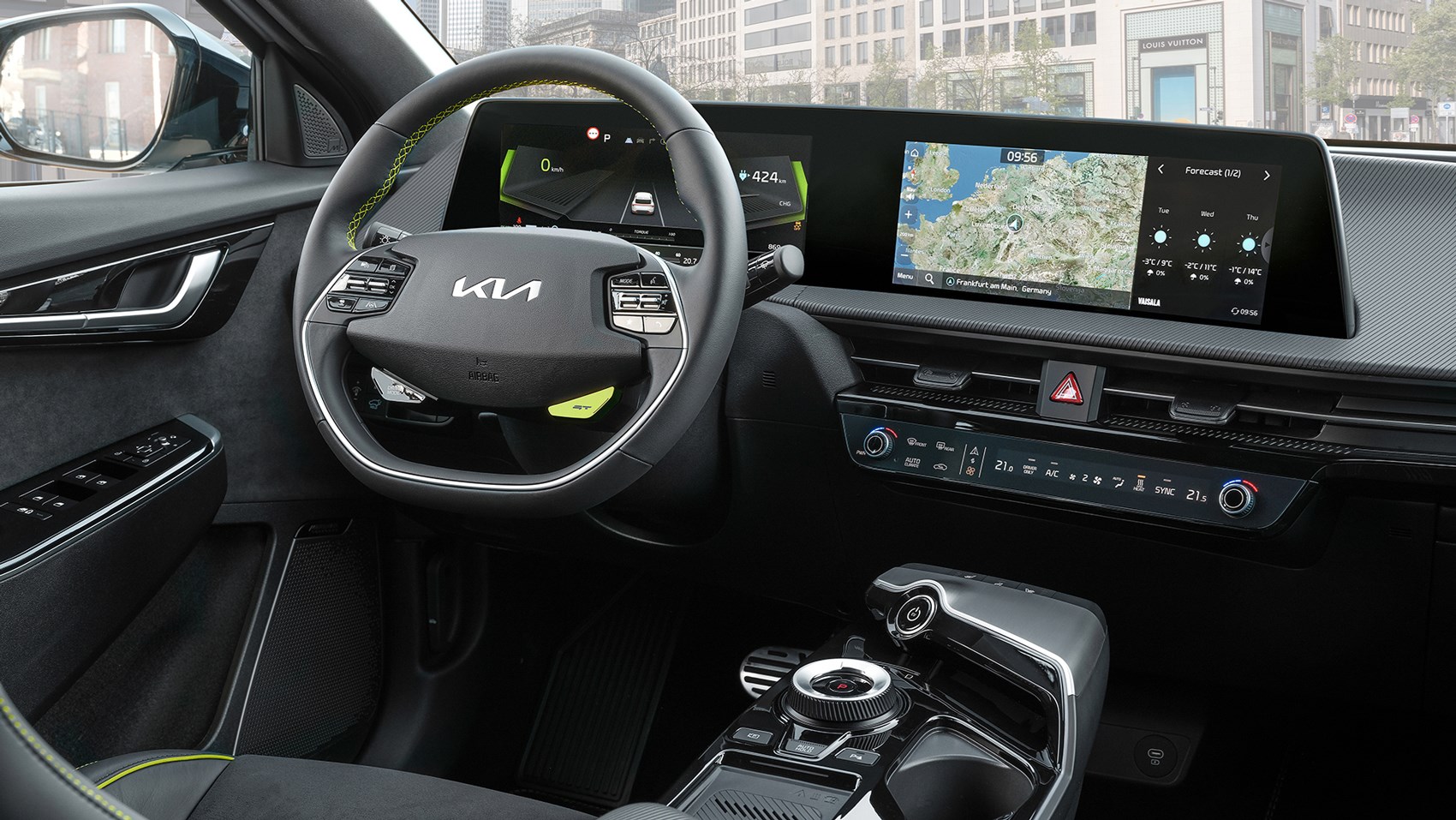
But the GT isn’t some skin-deep poser, the E-GMP platform and various controls have been overhauled to make this hot EV6 suitably, er… hot. A 160kW e-motor sits on the front axle, with a 270kW one on the rear, with the GT developing 577bhp in total and a pretty blistering 3.5sec 0-62mph launch time – only 0.4sec off a Tesla Model 3 Performance.
An electronic limited-slip differential is applied here to help shuffle the power around and 380/360mm front/rear brakes ensure plenty of stopping power. Biermann tells us the EV6 GT runs on Michelin Pilot Sport 4S rubber. ‘And we do all of these things in-house,’ says Biermann. ‘The bucket seats or the e-LSD, for example – we don’t outsource to Recaro or something – that gives us speed and you can adapt easily.’
Even with these upgrades, though, Biermann’s conscious the EV6 doesn’t get too much in the way of the upcoming Ioniq 5 N: ‘we won’t change the Hyundai N philosophy, even if we make an EV or hydrogen car. N is N. Period.
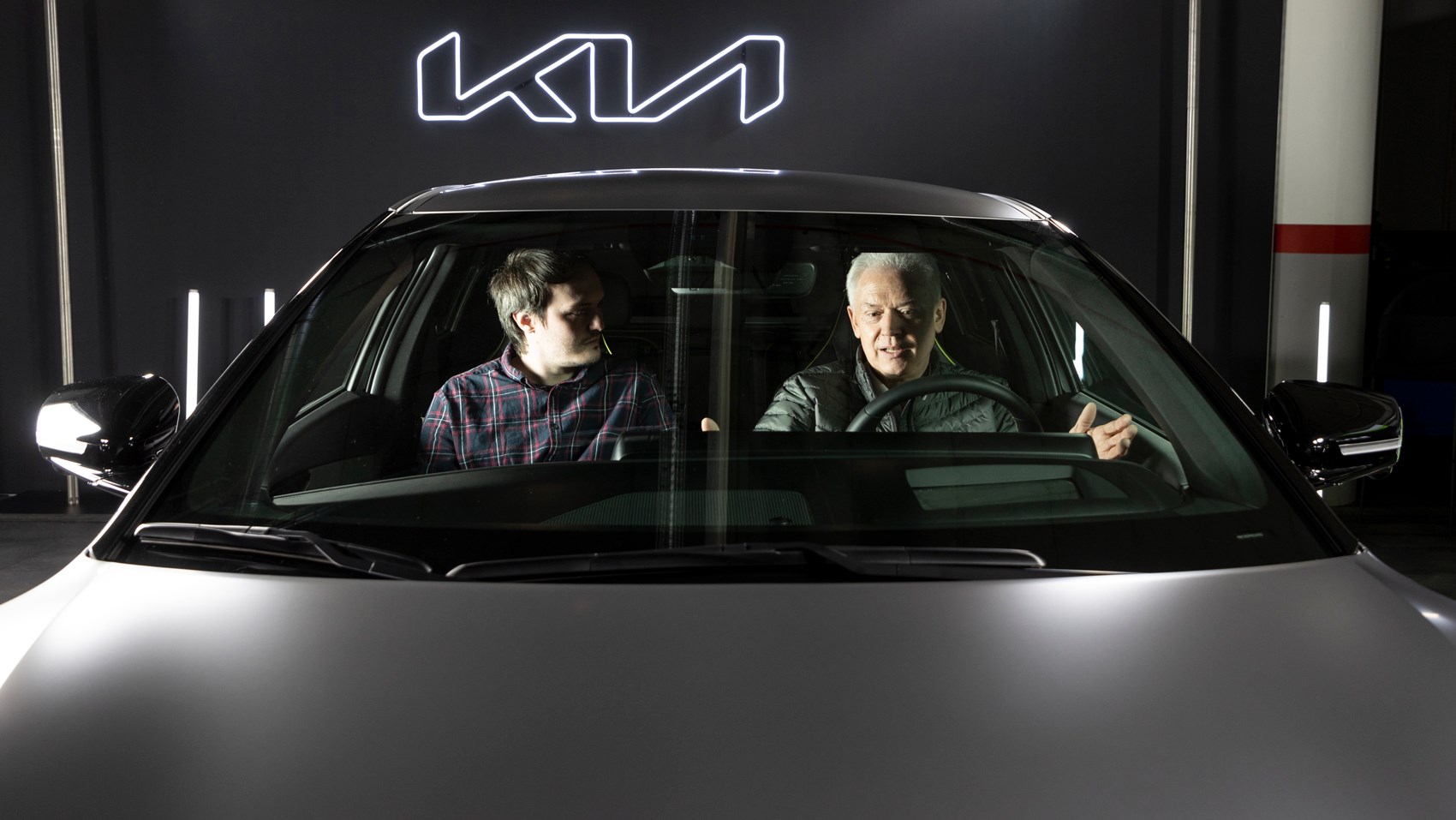
‘But Kia’s GT is a different story – we never claim this is a car for the racetrack; it’s more like. a fast cruiser. With N, we dig much deeper but GT has different priorities.
‘It’s always great to work with the Kia teams. When we started GT, I came here on my first business trip [after joining from BMW] and drove a GT car, then asked ‘what is a GT?’ The car I drove at the time was no GT car! Now though, after loads of development, the GT name really works for Kia. Just look at the Stinger GT.’ And he’s right – while the V6-powered Stinger isn’t a big seller by any stretch, and has its flaws, it introduced a fun handling balance never seen before by a car with a Kia badge on it.
And, even if the two performance arms are differentiated, there’s still customisability and a bit of fun in the EV6 GT. Thumb the anodised green GT button on the steering wheel unleashes the car’s most aggressive state, and you can even customise the parameters to your liking with My Mode. How does Biermann like it? ‘I have the damping in Normal, but everything else in Sport,’ he says.
‘We’ve even added a secret drift mode,’ he grins. ‘Start with it parked, press the GT button, push and hold ESC until it’s fully off, pull and hold both steering wheel paddles and you’re away!’ Duly noted, Mr Biermann…
So, what’s it like on the road?
It absolutely decimates the senses as Biermann stamps on the throttle, launching out of an on-ramp onto the Autobahn. He’s so focused as he carves up through the lanes, taking advantage of the GT’s deep power reserves; you can really feel that 3.5sec 0-62mph sprint time. ‘I did 266km/h (165mph) with some other guys the day before, let’s see if we can hit that again!’ says Biermann as he leans forward. Let’s bear in mind the GT tops out at 260kmh (162mph), and yet Biermann’s pushing for more.
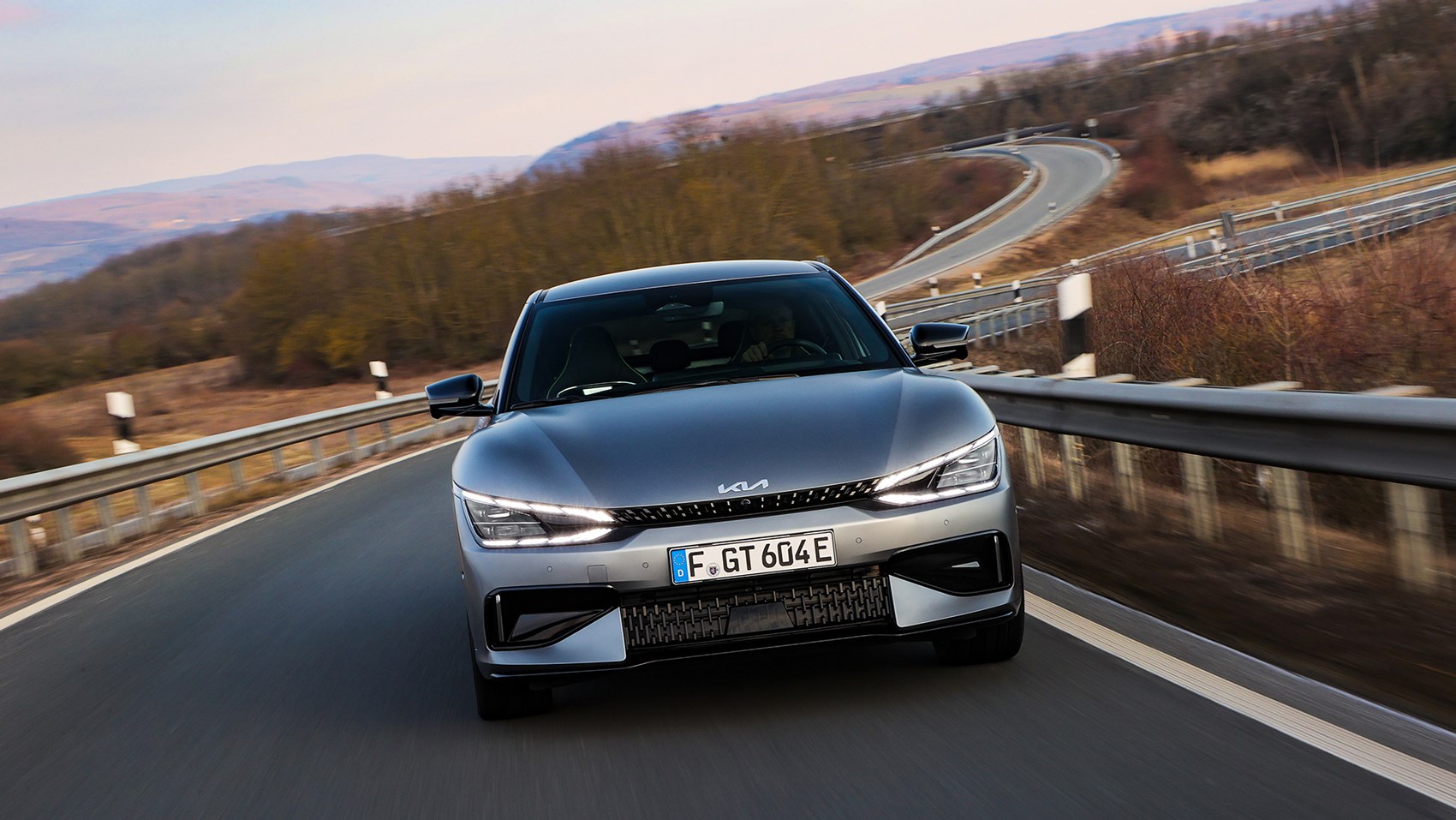
As the speed climbs so effortlessly, and I’m focusing on holding in my lunch, Biermann’s slicing and dicing between cars with aggressive lane changes so he can demonstrate the body control, grumbling about the increasing traffic that day preventing him from a long clear run. We clock 262kmh, but Biermann’s disappointed: ‘I blame the headwind,’ he laughs.
At that speed, it’s understandable that there would be some noise – the wind hits the door mirrors car hard, and that Michelin rubber roars. ‘But the Pilot Sport 4S aren’t exactly known for being a quiet tyre,’ says Biermann, before dropping anchor via the punchy brakes to a more respectable 100mph.
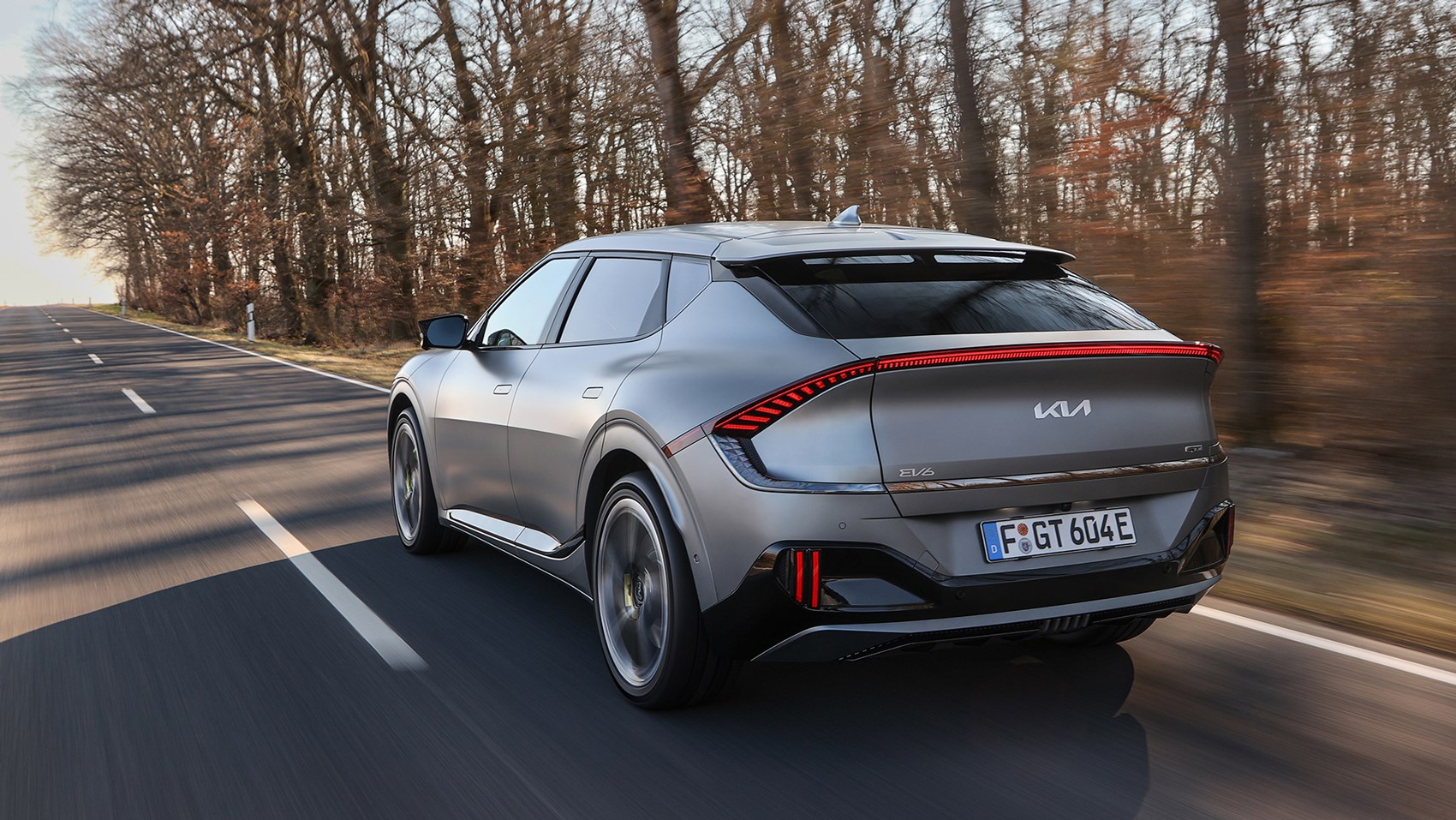
After that cooldown, you can get a better sense of the car at a non-handling guru’s pace. Wind and tyre noise are much more respectable even at a cool ton, and you’re likely to settle into those soft leather bucket seats a little more, too. All the while, Biermann’s waxing lyrical about the E-GMP’s efficiency and technology that outstrips most other rivals: ‘offering such a vehicle with such balance, refinement and with substantial new technology underneath? We won’t see that from other car makers for a while.’
And it’s not just outright acceleration that Biermann’s proud of, too – you can tell his time with his teams developing the GT’s dynamics has been worth it. You can definitely feel the car controlling itself through hard changes of direction, that inner gyroscope in your head unfazed by the low-level body roll and compliance.
Like any EV6, the GT has several steps of energy recouperation you can apply by the steering wheel paddles, with an ‘i-Pedal’ system that allows you to accelerate and brake only using the throttle. ‘We’re still fine-tuning the recuperation,’ says Biermann, ‘but with i-Pedal you get this nice, low weight transfer.
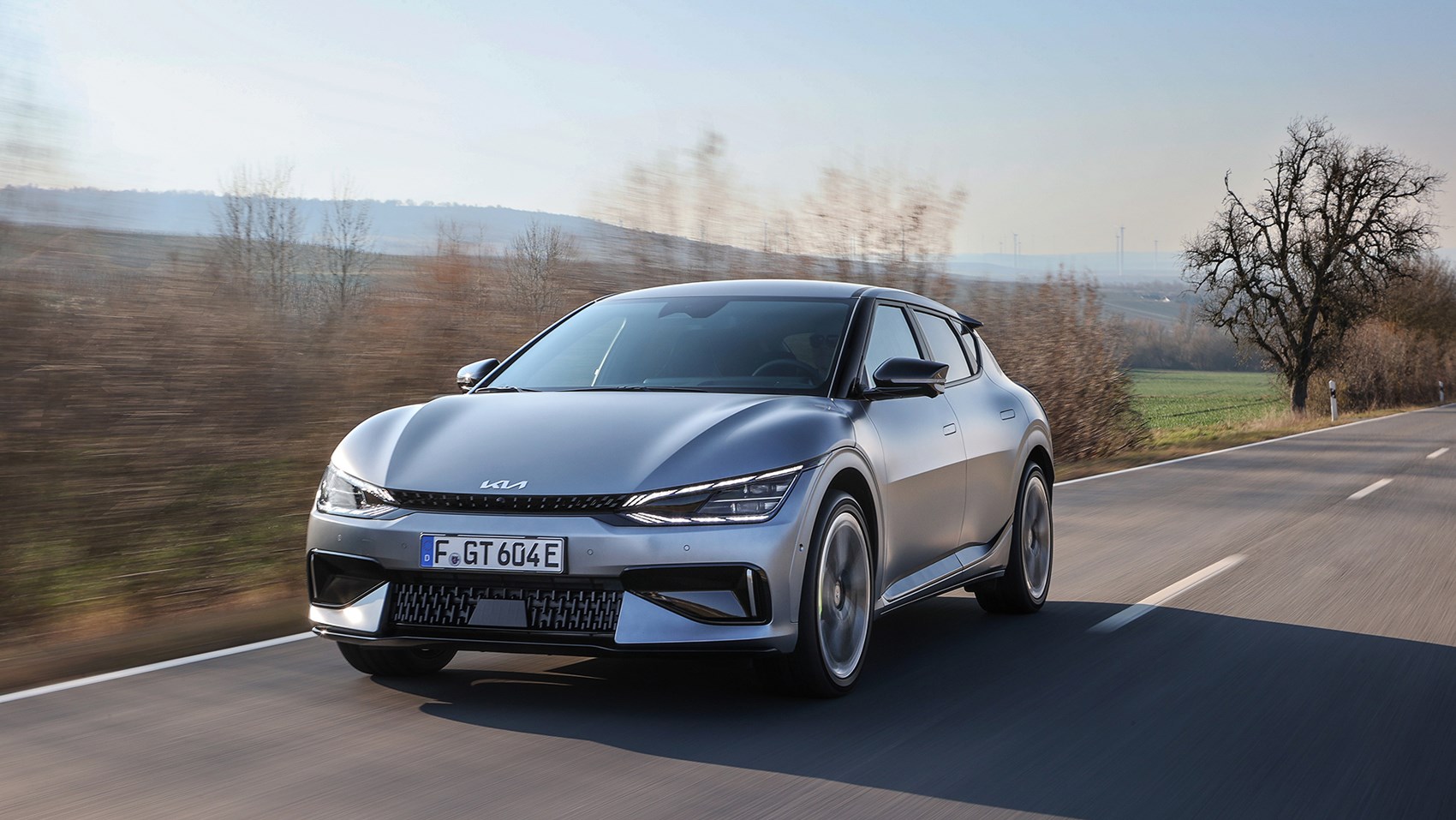
‘I took the first E-GMP cars out many times when I was in Korea. In the morning I’d go out in the mountain roads and I discovered the i-Pedal, you really come into a flow with it when you get off the throttle and get the low transfer in – it’s fantastic. You don’t load the front axle by using the brakes, so the potential of recouperation that has not been fully unleashed yet. You have to be very careful with recouperation – stability is always king, right?’
And at that moment, Biermann had a revelation: ‘Before, I looked at it like it was just an Eco mode – why would I ever drive on i-Pedal? This is for the eco freaks! But then I drove on those mountain roads – I don’t know why I switched on i-Pedal – I thought oh this is cool! Since that day I like it.’ We’d never looked at it that way before, either.
Kia EV6 GT: first impressions
Quick, attractive and well-made inside; even from the passenger seat, there are plenty of things to be impressed by with the new EV6 GT. We’ll have to wait and see what it’s like when we drive it for real.
